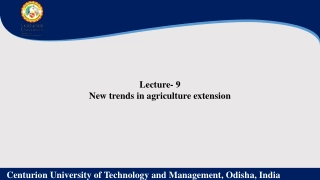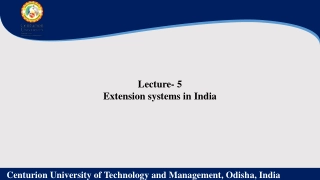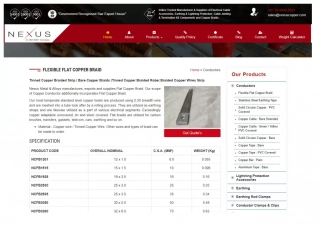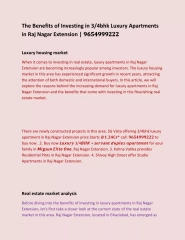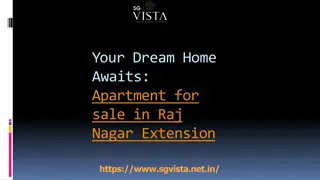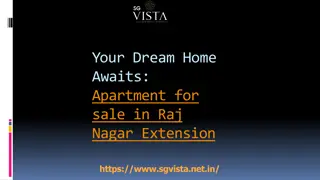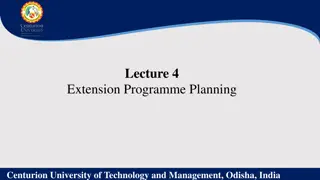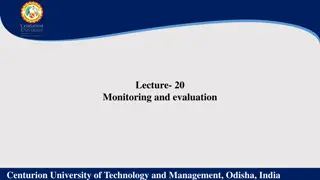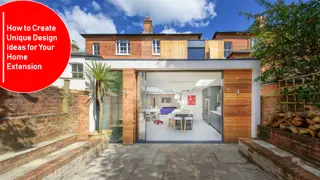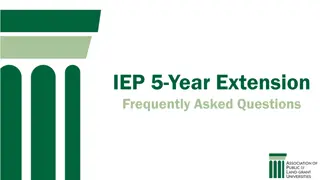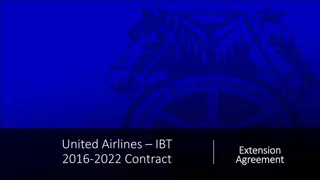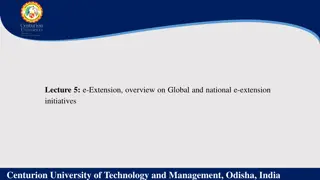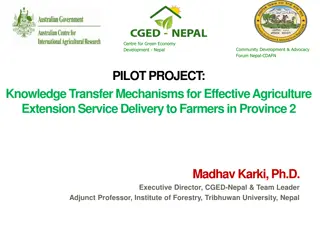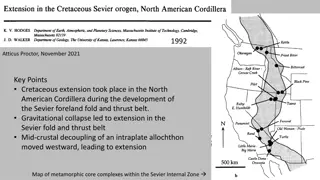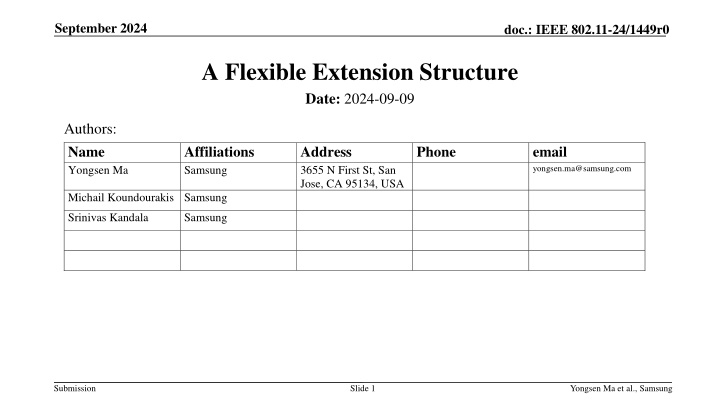
IEEE 802.11-24 Flexible Extension Structure Proposal
Explore the proposal for a flexible extension structure in IEEE 802.11-24, allowing support for multiple functions and future generations. The structure involves Extension Indication, Length, and Extension Context subfields to provide adaptability and efficiency in communication protocols.
Download Presentation

Please find below an Image/Link to download the presentation.
The content on the website is provided AS IS for your information and personal use only. It may not be sold, licensed, or shared on other websites without obtaining consent from the author. If you encounter any issues during the download, it is possible that the publisher has removed the file from their server.
You are allowed to download the files provided on this website for personal or commercial use, subject to the condition that they are used lawfully. All files are the property of their respective owners.
The content on the website is provided AS IS for your information and personal use only. It may not be sold, licensed, or shared on other websites without obtaining consent from the author.
E N D
Presentation Transcript
September 2024 doc.: IEEE 802.11-24/1449r0 A Flexible Extension Structure Date: 2024-09-09 Authors: Name Yongsen Ma Affiliations Samsung Address 3655 N First St, San Jose, CA 95134, USA Phone email yongsen.ma@samsung.com Michail Koundourakis Samsung Srinivas Kandala Samsung Submission Slide 1 Yongsen Ma et al., Samsung
September 2024 doc.: IEEE 802.11-24/1449r0 Abstract Some proposals are reusing existing frame/field/element for different purposes, such as coexistence, power save, NPCA, DSO [1-4] Some frame/field/element does not have enough reserved bits Some proposals are reusing AID12 for different purposes [4-6] Some frame/field/element does not have the AID12 subfield This submission presents a flexible extension structure One bit in existing field or UHR field for Extension Indication to support multiple functions It can also be used to support optional functions or to support new functions for future 802.11 generations Submission Slide 2 Yongsen Ma et al., Samsung
September 2024 doc.: IEEE 802.11-24/1449r0 Proposal: A Flexible Extension Structure The Extension Indication subfield indicates the presence of Length and Extension Context. When Extension Indication is 0: the Length and Extension Context subfields are not present. When Extension Indication is 1: STAs that do not understand or do not need the Extension Context can skip it by the Length subfield. STAs that understand the Extension Context can process it and take actions accordingly. The Length subfield indicates the number of octets in the Extension Context subfield. It may support different functions for 802.11bn and new functions for future 802.11 generations. Present in extensible field/subfield Present if Extension Indication subfield is 1 Extensible field/subfield Extension Indication Some fixed length Length 0 or TBD Extension Context variable Bits: 1 Submission Slide 3 Yongsen Ma et al., Samsung
September 2024 doc.: IEEE 802.11-24/1449r0 Comparison with Information Elements (1/2) The proposed extension structure is similar to Information Elements. Present in extensible field/subfield Present if Extension Indication subfield is 1 Extensible field/subfield Extension Indication Some fixed length Length 0 or TBD Extension Context variable Bits: 1 The proposed structure IEEE 802.11-2020 [7] Submission Slide 4 Yongsen Ma et al., Samsung
September 2024 doc.: IEEE 802.11-24/1449r0 Comparison with Information Elements (2/2) The proposed structure is not limited to management frames; can be used for any field/subfield of MAC header of any frame. May also work for certain PPDU fields in PHY header. E.g., if certain PPDU field has no difference between two generations, the Extension Indication is 0. Otherwise the Extension Indication is 1, followed by the Extension Context for the new generation. Simple change with low overhead (as low as 1 bit) Closely coupled with the specific field/subfield that is to be extended, which can be more efficient and effective for legacy STAs, UHR STAs and future generation STAs Element ID is not needed and no need to occupy the Element ID or Element ID Extension space, although ID/type/version information can be included in the Extension Context If Extension Indication is 1, The Extension Context can be ignored by certain STAs that do not understand or do not need the Extension Context No need to follow the relative Order, check the capability for the presence of each Element, and try to match the Element ID to process each Element Submission Slide 5 Yongsen Ma et al., Samsung
September 2024 doc.: IEEE 802.11-24/1449r0 Options for Multiple, Optional and Future Functions Extend existing field to support multiple functions Extension Indication: reuse 1 bit in the existing field (reserved bit or multi-purpose bit). Set to false to disable Extension Context (baseline), set to true to support extended functions. Extension Context: ID/type information to identify different functions; Extension Context can also contain Extension Indication to be extended further in the future if needed. If the existing field has a subfield with variable length that can be matched with the Length subfield, the Extension Context can be appended right after the existing field. Otherwise, the Extension Context can be appended at the end of the MAC header. Define new field to support optional functions and new functions in the future Extension Indication: 1 bit in 802.11bn fields for optional/future extensions. Set to false for basic 802.11bn functions, set to true for optional 802.11bn functions or for new functions for future 802.11 generations. Extension Context: present if optional or post-802.11bn functions are enabled. Slide 6 Submission Yongsen Ma et al., Samsung
September 2024 doc.: IEEE 802.11-24/1449r0 Options for Unicast and Broadcast/Multicast Frames For unicast frames, STAs that understand the Extension Indication (for UHR and post-UHR STAs) can process or ignore the Extension Context. Do not send unicast frames with Extension Indication = 1 to legacy STAs, unless legacy STAs can skip the Extension Context properly. For broadcast/multicast frames, For Management frames, Use certain reserved Element IDs, so legacy STAs can skip the Information field of the Element For Control frames, Use certain reserved type/subtype/AID values, so legacy STAs can skip the information/context associated with the type/subtype/AID For Data frames, Use certain reserved Control ID values of the A-Control subfield, so legacy STAs can skip the Control Information of the A-Control subfield Submission Slide 7 Yongsen Ma et al., Samsung
September 2024 doc.: IEEE 802.11-24/1449r0 Options for Frame Format Location of Extension Indication subfield At the end of the extensible field Anywhere of the extensible field that is unused/reserved/multi-purpose Location of Length subfield and Extension Context subfield Right after the extensible field A dedicated part (e.g., at the end of MAC header) for a list of Length + Extension Context subfields, following the same order as the extensible fields Content of Extension Indication subfield One bit in a extensible field For existing field/subfield: reuse reserved bit, or reuse certain multi-purpose subfield value For new field/subfield: define a dedicated bit for Extension Indication May have one bit to indicate whether a field is extensible or not Content of Extension Context subfield: TBD. Size of Length subfield: one octet or TBD Slide 8 Submission Yongsen Ma et al., Samsung
September 2024 doc.: IEEE 802.11-24/1449r0 Examples (1/3) Example 1: Extension Indication at the end of the extensible field, followed by Length and Extension Context Example 2: Extension Indication at the middle of the extensible field, followed by Length and Extension Context Example 3: Extension Indication at the middle of the extensible field, followed by other field(s) and then followed by Length and Extension Context Example 2 Example 1 Example 3 Submission Slide 9 Yongsen Ma et al., Samsung
September 2024 doc.: IEEE 802.11-24/1449r0 Examples (2/3) Example 4: two extensible fields, each followed by Length and Extension Context, and with other field(s) between them Example 5: two extensible fields, followed by other field(s), and then Length and Extension Context Example 6: mix of example 4 and example 5 Example 4 Example 5 Example 6 Submission Slide 10 Yongsen Ma et al., Samsung
September 2024 doc.: IEEE 802.11-24/1449r0 Examples (3/3) Example 7: concatenated and continuous Extension Context subfields with no other field in between, and the first level of Length subfield indicates the overall length of two levels of Extension Context Example 8: concatenated and continuous Extension Context subfields with no other field in between, and the Length subfield of each level indicates the length of each level of Extension Context separately Example 9: concatenated and non-continuous Extension Context subfields with other field(s) in between, and the Length subfield of each level indicates the length of each level of Extension Context separately Example 7 Example 8 Example 9 Submission Slide 11 Yongsen Ma et al., Samsung
September 2024 doc.: IEEE 802.11-24/1449r0 Conclusion This submission presents a flexible extension structure with Extension Indication, Length, and Extension Context subfields It can be used to extend existing fields to support multiple functions It can be used in extensible fields to support optional functions It can be used in extensible fields to support new functions for future 802.11 generations Submission Slide 12 Yongsen Ma et al., Samsung
September 2024 doc.: IEEE 802.11-24/1449r0 References [1] 802.11-24/1126r1, ICF-ICR Discussion for DPS, GeonHwan Kim [2] 802.11-24/0504r0, Considerations of A Unified Initial Control Frame Design, Hanqing Lou [3] 802.11-24/0505r0, Considerations of Transmissions of Initial Control Response frames, Hanqing Lou [4] 802.11-24/0857r0, ICR consideration, Liwen Chu [5] 802.11-24/1129r1, Discussion on Intermediate FCS Signaling, SunHee Baek [6] 802.11-24/1179r0, Trigger frame expansion, Vishnu Ratnam [7] IEEE Std 802.11-2020 Submission Slide 13 Yongsen Ma et al., Samsung
September 2024 doc.: IEEE 802.11-24/1449r0 Straw Polls SP1: Do you support defining a mechanism in TGbn to allow a field to be extended? An extensible field is similar to an (extensible) Information Element, but not limited to management frame Signaling for the indication is TBD, e.g., by capability bits or reserved subfields/values Naming and procedures for the mechanism are TBD Results: Yes: , No: , Abstain: Submission Slide 14 Yongsen Ma et al., Samsung
September 2024 doc.: IEEE 802.11-24/1449r0 Straw Polls SP2: Do you support defining a mechanism in TGbn to indicate whether a field is extended? If a field is extended, it is followed by a length subfield and an extension context subfield Exact location and context of extension indication, length subfield and extension context subfield are TBD Naming and procedures for the mechanism are TBD Results: Yes: , No: , Abstain: Submission Slide 15 Yongsen Ma et al., Samsung

